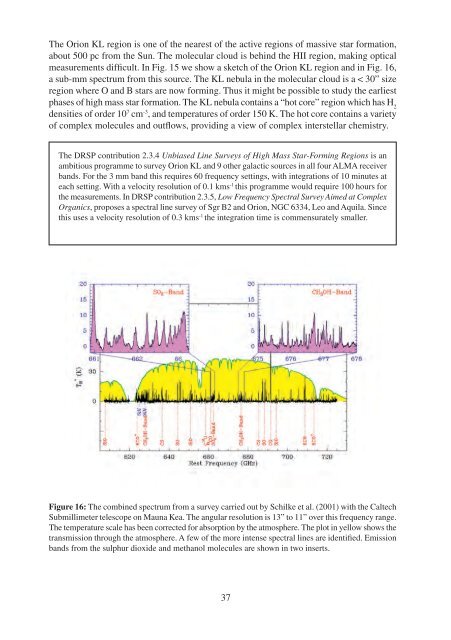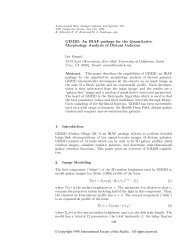4 Comparison of the ALMA and Herschel - ESO
4 Comparison of the ALMA and Herschel - ESO
4 Comparison of the ALMA and Herschel - ESO
You also want an ePaper? Increase the reach of your titles
YUMPU automatically turns print PDFs into web optimized ePapers that Google loves.
The Orion KL region is one <strong>of</strong> <strong>the</strong> nearest <strong>of</strong> <strong>the</strong> active regions <strong>of</strong> massive star formation,<br />
about 500 pc from <strong>the</strong> Sun. The molecular cloud is behind <strong>the</strong> HII region, making optical<br />
measurements difficult. In Fig. 15 we show a sketch <strong>of</strong> <strong>the</strong> Orion KL region <strong>and</strong> in Fig. 16,<br />
a sub-mm spectrum from this source. The KL nebula in <strong>the</strong> molecular cloud is a < 30” size<br />
region where O <strong>and</strong> B stars are now forming. Thus it might be possible to study <strong>the</strong> earliest<br />
phases <strong>of</strong> high mass star formation. The KL nebula contains a “hot core” region which has H 2<br />
densities <strong>of</strong> order 10 7 cm -3 , <strong>and</strong> temperatures <strong>of</strong> order 150 K. The hot core contains a variety<br />
<strong>of</strong> complex molecules <strong>and</strong> outflows, providing a view <strong>of</strong> complex interstellar chemistry.<br />
The DRSP contribution 2.3.4 Unbiased Line Surveys <strong>of</strong> High Mass Star-Forming Regions is an<br />
ambitious programme to survey Orion KL <strong>and</strong> 9 o<strong>the</strong>r galactic sources in all four <strong>ALMA</strong> receiver<br />
b<strong>and</strong>s. For <strong>the</strong> 3 mm b<strong>and</strong> this requires 60 frequency settings, with integrations <strong>of</strong> 10 minutes at<br />
each setting. With a velocity resolution <strong>of</strong> 0.1 kms -1 this programme would require 100 hours for<br />
<strong>the</strong> measurements. In DRSP contribution 2.3.5, Low Frequency Spectral Survey Aimed at Complex<br />
Organics, proposes a spectral line survey <strong>of</strong> Sgr B2 <strong>and</strong> Orion, NGC 6334, Leo <strong>and</strong> Aquila. Since<br />
this uses a velocity resolution <strong>of</strong> 0.3 kms -1 <strong>the</strong> integration time is commensurately smaller.<br />
Figure 16: The combined spectrum from a survey carried out by Schilke et al. (2001) with <strong>the</strong> Caltech<br />
Submillimeter telescope on Mauna Kea. The angular resolution is 13” to 11” over this frequency range.<br />
The temperature scale has been corrected for absorption by <strong>the</strong> atmosphere. The plot in yellow shows <strong>the</strong><br />
transmission through <strong>the</strong> atmosphere. A few <strong>of</strong> <strong>the</strong> more intense spectral lines are identified. Emission<br />
b<strong>and</strong>s from <strong>the</strong> sulphur dioxide <strong>and</strong> methanol molecules are shown in two inserts.<br />
37




